RPS2
-
Official Full Name
ribosomal protein S2 -
Overview
Ribosomes, the organelles that catalyze protein synthesis, consist of a small 40S subunit and a large 60S subunit. Together these subunits are composed of 4 RNA species and approximately 80 structurally distinct proteins. This gene encodes a ribosomal protein that is a component of the 40S subunit. The protein belongs to the S5P family of ribosomal proteins. It is located in the cytoplasm. This gene shares sequence similarity with mouse LLRep3. It is co-transcribed with the small nucleolar RNA gene U64, which is located in its third intron. As is typical for genes encoding ribosomal proteins, there are multiple processed pseudogenes of this gene dispersed through the genome. -
Synonyms
RPS2;ribosomal protein S2;40S ribosomal protein S2;LLREP3;S2;OK/KNS-cl.6;protein LLRep3;40S ribosomal protein S4;MGC102851;MGC117344;MGC117345
Recombinant Proteins
- Zebrafish
- Mouse
- Human
- Chicken
- Rat
- Mammalian Cells
- Wheat Germ
- E.coli
- HEK293
- In Vitro Cell Free System
- His
- Non
- Avi
- Fc
| Cat.# | Product name | Source (Host) | Species | Tag | Protein Length | Price |
|---|---|---|---|---|---|---|
| RPS2-12472Z | Recombinant Zebrafish RPS2 | Mammalian Cells | Zebrafish | His |
|
|
| RPS2-14477M | Recombinant Mouse RPS2 Protein | Mammalian Cells | Mouse | His |
|
|
| RPS2-29468TH | Recombinant Human RPS2 | Wheat Germ | Human | Non | 293 amino acids |
|
| RPS2-306H | Recombinant Human ribosomal protein S2, His-tagged | E.coli | Human | His | 1-293 a.a. |
|
| RPS2-4749C | Recombinant Chicken RPS2 | Mammalian Cells | Chicken | His |
|
|
| RPS2-5157R | Recombinant Rat RPS2 Protein | Mammalian Cells | Rat | His |
|
|
| RPS2-2168HCL | Recombinant Human RPS2 293 Cell Lysate | HEK293 | Human | Non |
|
|
| RPS2-443HF | Recombinant Full Length Human RPS2 Protein | In Vitro Cell Free System | Human | Full L. 293 amino acids |
|
|
| RPS2-4816R | Recombinant Rat RPS2 Protein, His (Fc)-Avi-tagged | HEK293 | Rat | Avi&Fc&His |
|
|
| RPS2-4816R-B | Recombinant Rat RPS2 Protein Pre-coupled Magnetic Beads | HEK293 | Rat |
|
||
| RPS2-7777M | Recombinant Mouse RPS2 Protein, His (Fc)-Avi-tagged | HEK293 | Mouse | Avi&Fc&His |
|
|
| RPS2-7777M-B | Recombinant Mouse RPS2 Protein Pre-coupled Magnetic Beads | HEK293 | Mouse |
|
Background
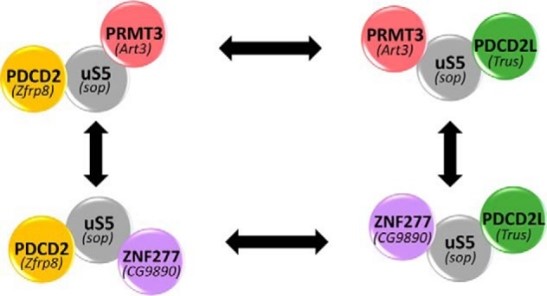
Fig1. Protein complexes revolving around extraribosomal uS5. (Kiersten L Dionne, 2019)
What is RPS2 protein?
RPS2 gene (ribosomal protein S2) is a protein coding gene which situated on the short arm of chromosome 16 at locus 16p13. Ribosomes, the organelles that catalyze protein synthesis, consist of a small 40S subunit and a large 60S subunit. Together these subunits are composed of 4 RNA species and approximately 80 structurally distinct proteins. This gene encodes a ribosomal protein that is a component of the 40S subunit. The protein belongs to the S5P family of ribosomal proteins. It is located in the cytoplasm. This gene shares sequence similarity with mouse LLRep3. It is co-transcribed with the small nucleolar RNA gene U64, which is located in its third intron. The RPS2 protein is consisted of 293 amino acids and RPS2 molecular weight is approximately 31.3 kDa.
What is the function of RPS2 protein?
The specific functions of RPS2 protein in ribosomes include: it participates in the structure of small subunits of ribosomes and is essential for maintaining the integrity and function of ribosomes. It may be involved in the assembly process of ribosomes, working together with other ribosomal proteins and rRNA to form efficient protein synthesis factories. In plants, RPS2 is a gene associated with plant disease resistance that contains leucine-rich repeats, transmembrane regions, leucine zippers, and P-ring domains. The function of RPS2 gene products involves triphosphate nucleotide binding and protein-protein interactions, and may also include the reception of elicitors produced by non-toxic pathogens.
RPS2 Related Signaling Pathway
In the plant immune system, RPS2 is associated with the pattern recognition receptor (PRR) signaling pathway and the Effect-triggered immunity (ETI) signaling pathway. PTI is a plant's initial defense response to pathogen-associated molecular patterns (PAMPs), while ETI is a deeper immune response to specific pathogen effectors. Rps2-mediated signaling can lead to hypersensitivity (HR) in plant cells, a form of local cell death associated with pathogen infection that helps limit the spread of pathogens. RPS2 may be involved in cellular response to various stress conditions, including oxidative stress and DNA damage, regulating cellular stress responses by affecting ribosome function and protein synthesis.
RPS2 Related Diseases
The RPS2 protein has been implicated in a variety of diseases, especially in plant and human diseases. In plants, particularly in Arabidopsis Thaliana, RPS2 is a gene associated with disease resistance that is involved in pathogen recognition and defense responses through its interaction with the RIN4 protein and is critical for resistance to pathogens such as Pseudomonas syringae. In humans, abnormal expression of RPS2 is associated with the development of certain types of cancer, such as prostate cancer, which is upregulated in malignant prostate cancer cell lines and archived tumor samples. In addition, RPS2 is associated with other diseases such as acute T-lymphoblastic leukemia, cardiovascular and metabolic diseases, and ribosomal diseases. Ribosomal diseases are a group of rare genetic disorders caused by mutations in the RP gene that affect ribosome assembly and function, such as Diamond-Blackfan Anemia (DBA) and 5q syndrome.
Bioapplications of RPS2
RPS2, as a ribosomal protein that is overexpressed in some cancers, has become a target for studying cancer pathogenesis and developing new therapies. Applications of RPS2 in plant pathology are also important, particularly in Arabidopsis, where RPS2 acts as a disease resistance gene to help understand how plants recognize pathogens and activate defense mechanisms. This has facilitated the development of disease-resistant crop varieties. Abnormal expression or dysfunction of RPS2 is also associated with a variety of diseases, including hematological, cardiovascular, and metabolic diseases, providing new biomarkers and potential therapeutic directions for disease diagnosis and treatment.
Case Study
Case Study 1: Andreas Steiner, 2023
The ribosome is assembled in a complex process mainly taking place in the nucleus. Consequently, newly synthesized ribosomal proteins have to travel from the cytoplasm into the nucleus, where they are incorporated into nascent ribosomal subunits. In this study, researchers set out to investigate the mechanism mediating nuclear import of the small subunit ribosomal protein Rps2. They demonstrate that an internal region in Rps2, ranging from amino acids 76 to 145, is sufficient to target a 3xyEGFP reporter to the nucleus. Moreover, our data reveal a second import mechanism involving the N-terminal region of Rps2, which depends on the presence of basic residues within amino acids 10 to 28. This Rps2 segment overlaps with the binding site of the dedicated chaperone Tsr4; however, the nuclear import of Rps2 via the internal as well as the N-terminal nuclear-targeting element does not depend on Tsr4.
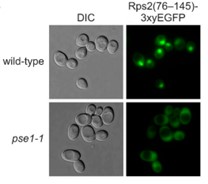
Fig1. Localization of Rps2(76–145)-3xyEGFP visualized by fluorescence microscopy.
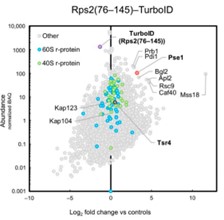
Fig2. TurboID-based proximity labeling with Rps2(76–145).
Case Study 2: Yin Feng, 2023
Although NPM1 mutations are frequently found in acute myeloid leukemia patients, therapeutic strategies are scarce and unsuitable for those who cannot tolerate intensive chemotherapy. Here researchers demonstrated that heliangin, a natural sesquiterpene lactone, exerts favorable therapeutic responses in NPM1 mutant acute myeloid leukemia cells, with no apparent toxicity to normal hematogenous cells, by inhibiting their proliferation, inducing apoptosis, causing cell cycle arrest, and promoting differentiation. In-depth studies on its mode of action using quantitative thiol reactivity platform screening and subsequent molecular biology validation showed that the ribosomal protein S2 (RPS2) is the main target of heliangin in treating NPM1 mutant AML. Upon covalent binding to the C222 site of RPS2, the electrophilic moieties of heliangin disrupt pre-rRNA metabolic processes, leading to nucleolar stress, which in turn regulates the ribosomal proteins-MDM2-p53 pathway and stabilizes p53.
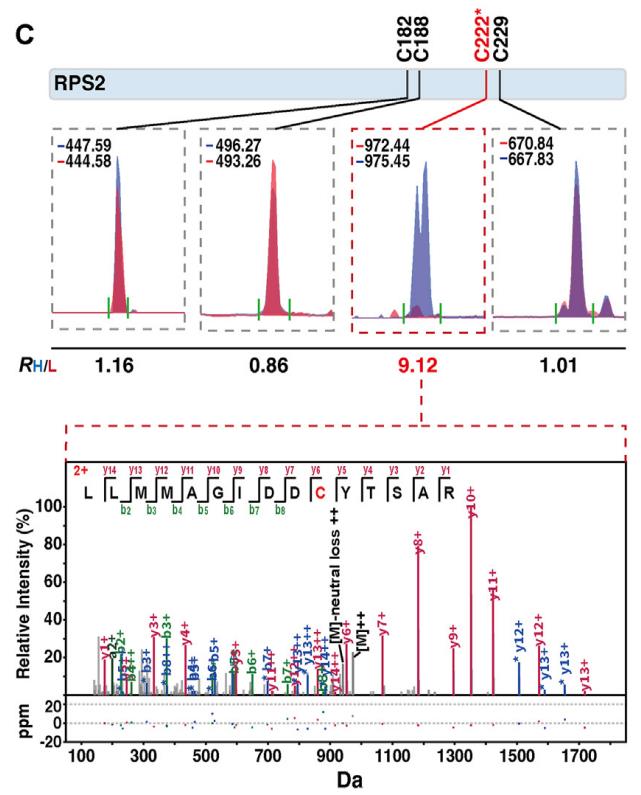
Fig3. Representative MS1 profiles for multiple cysteine-containing peptides from the RPS2 protein.
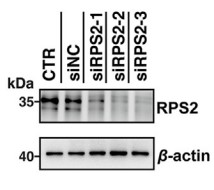
Fig4. Expression of RPS2 protein and loading control actin levels in OCI-AML3 cells.
Involved Pathway
RPS2 involved in several pathways and played different roles in them. We selected most pathways RPS2 participated on our site, such as Ribosome, which may be useful for your reference. Also, other proteins which involved in the same pathway with RPS2 were listed below. Creative BioMart supplied nearly all the proteins listed, you can search them on our site.
| Pathway Name | Pathway Related Protein |
|---|---|
| Ribosome | RPL34,RPLP1,MRPS7,RPL26L1,RPL28,RPL13A,RPL17,RPS27.2,MRPL4,RPS16 |
Protein Function
RPS2 has several biochemical functions, for example, enzyme binding,fibroblast growth factor binding,mRNA binding. Some of the functions are cooperated with other proteins, some of the functions could acted by RPS2 itself. We selected most functions RPS2 had, and list some proteins which have the same functions with RPS2. You can find most of the proteins on our site.
| Function | Related Protein |
|---|---|
| fibroblast growth factor binding | SCN5A,RPS19,KLB,FGFR2,PTPRZ1,FIBPB,Api5,GLG1B,FGFBP3,CEP57 |
| structural constituent of ribosome | MRPS17,RPS19,MRPL32,MRPS24,RPS16,MRPS22,FAU,MRPL18,RPS5,RPL3 |
| mRNA binding | LIN28A,DOM3Z,CCDC55,ELAVL1,NUDT21,FXR2,RBFOX1,D19BWG1357E,RPS3,RPS13 |
| poly(A) RNA binding | GM5506,RPL19,NOL12,PTPN1,RBM42,PUS1,CNOT1,ROCK2,DDX39,OASL |
| protein binding | TSKS,ANGPT1,MCCC1,KPNA4,BRAP,GPN3,YOD1,LNX1,ITGB7,PTPRO |
| enzyme binding | UGT1A6A,PARP4,GBP1,HAND1,KDM4C,TOP2B,KDM1A,MAP2K7,PTPLA,MAPT |
Interacting Protein
RPS2 has direct interactions with proteins and molecules. Those interactions were detected by several methods such as yeast two hybrid, co-IP, pull-down and so on. We selected proteins and molecules interacted with RPS2 here. Most of them are supplied by our site. Hope this information will be useful for your research of RPS2.
GABARAPL2;VCAM1;LRRK2;ESR1;TK1;ANXA7;GADD45A;SOX5;CDKN1A;MLH1;GSK3B;DNM2;MPP3
Resources
Related Services
Related Products
References
- Rugjee, KN; Chaudhury, SR; et al. Fluorescent protein tagging confirms the presence of ribosomal proteins at Drosophila polytene chromosomes. PEERJ 1:-(2013).
- Zidane, N; Ould-Abeih, MB; et al. The folded and disordered domains of human ribosomal protein SA have both idiosyncratic and shared functions as membrane receptors. BIOSCIENCE REPORTS 33:113-124(2013).



